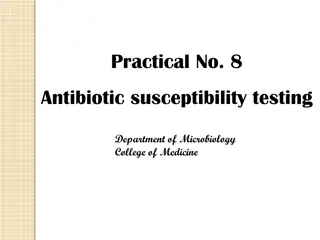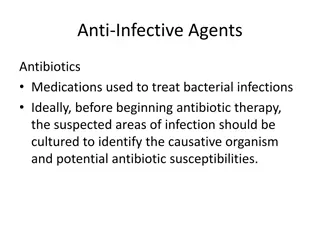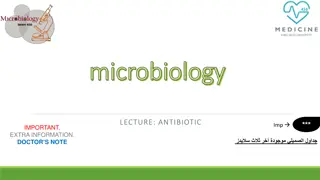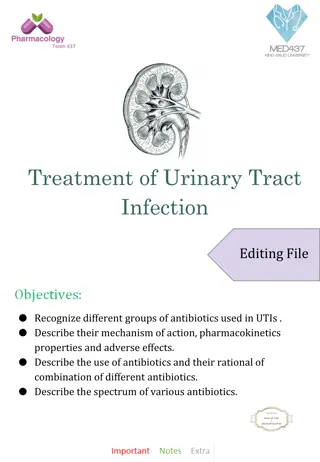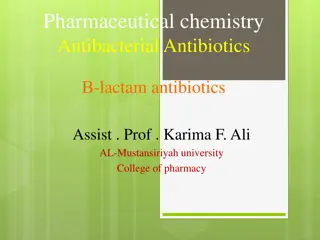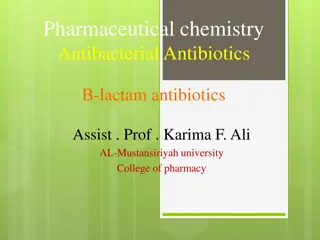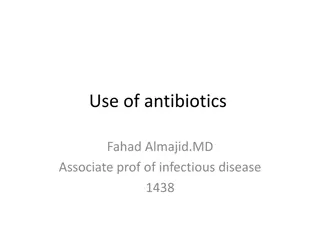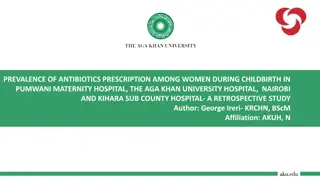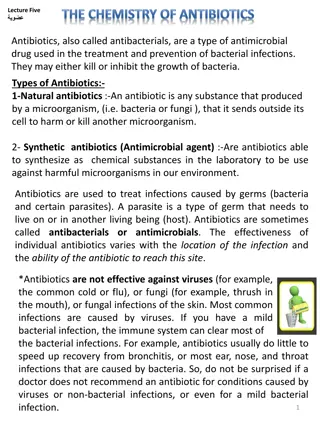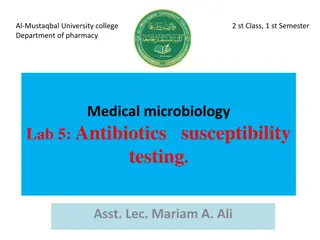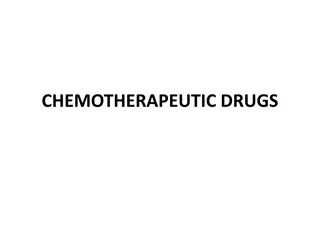Understanding Antibiotics: Types, Mechanisms, and Testing
Antibiotics are compounds produced by living organisms that inhibit or kill other organisms, categorized as bactericidal or bacteriostatic. This article explores the types of antibiotics, mechanisms of action against bacteria, and the importance of sensitivity testing to determine drug effectiveness and dosage. Learn about antibiotic susceptibility testing methods and terminology used in assessing bacterial response to antibiotics.
Download Presentation

Please find below an Image/Link to download the presentation.
The content on the website is provided AS IS for your information and personal use only. It may not be sold, licensed, or shared on other websites without obtaining consent from the author. Download presentation by click this link. If you encounter any issues during the download, it is possible that the publisher has removed the file from their server.
E N D
Presentation Transcript
ANTIBIOTIC By:Afnan Bakhsh
Sir Alexander Fleming (1881 1955) One sometimes finds what one is not looking for Penicillin He observed inhibition of staphylococci on an agar plate contaminated by a Penicillium mold
Antibiotic: Its a compound produced by living organism which inhibit or kills other organism. It can be: Bactericidal: antibiotic that kills the bacteria. Bacteriostatic: antibiotic that inhibits the growth of bacteria.
Types of antibiotics: 1- broad-spectrum: If it is effective against both gram +ve and gram ve organisms. 2- narrow-spectrum: If it is effective against gram +ve only or gram ve organisms only.
Antibiotics mechanisms of action against bacteria: Inhibition of DNA synthesis. Inhibition of protein synthesis Inhibition of cell wall synthesis Inhibition of cell membrane function 1. 2. 3. 4.
Why do we do sensitivity testing?? 1-To know which drug we use to the patient. 2-To Know the dose of antibiotic. It is important to use the lowest effective concentration of the antibiotic to avoid toxicity in patient.
Antibiotic susceptibility test: We have to test the susceptibility of bacteria to several antibiotics to check if the bacteria is sensitive or resistant to the used antibiotic. Methods of Antibiotic susceptibility test: 1) Broth dilution 2) Agar diffusion (solid) : 1) Kirby-Bauer method: 2) Stoke's method :
Termenology Sensitive (=Susceptible): Organism is inhibited by this antibiotic. Resistant: Organism is not inhibited by this antibiotic. Intermediate: Organism response to antibiotic may be lower than for the sensitive isolates. And usually the drug should be used in higher than normal dosage.
1) Kirby-Bauer method: We use: Muller Hinton agar (MH) Test bacteria (from the patient) Antibiotics discs Result: If the bacteria are sensitive to the antibiotic we will see inhibition zone. If the bacteria are resistance to the antibiotic we will NOT see the inhibition zone.
2) Stoke's method: We use: 1-Muller Hinton agar (MH) 2-Test bacteria (from the patient) and Control bacteria (from the reference lab) 3-Antibiotics discs
Results of Stockes Method: Result: If the inhibition zone of the test organism is bigger or equal to the inhibition zone of the control organism that means that the bacteria is sensitive to the antibiotic. If the inhibition zone of the test organism is smaller to the inhibition zone of the control organism that means that the bacteria is resistance to the antibiotic. T > C or T = C Sensitive T< C Resistance
: Broth Dilution Method MIC (minimum inhibitory concentration): This test to know the minimum concentration of antibiotic that can inhibit or kill the bacteria growth. MIC of the test is the last tube that shows No growth.



